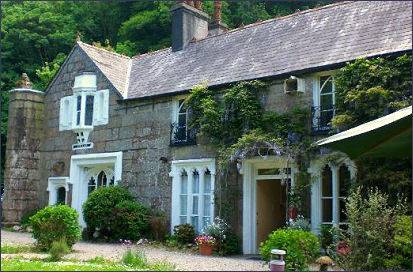Lanivet
OS Grid ref:- SX 039 642
 The village of Lanivet is situated around 2 1/2 miles to the (4.0 km) southwest of Bodmin and stands at the geographical centre of Cornwall.
The village of Lanivet is situated around 2 1/2 miles to the (4.0 km) southwest of Bodmin and stands at the geographical centre of Cornwall.
The village is known in Cornish as Lanneves, which means lann 'sacred enclosure' and Neves - 'pagan sacred place'. The earliest recorded mention of the name is as Lannived in 1268.
The village church, a grade I listed building, stands adjacent to the village green and dates mostly from the fifteenth century. The dedication of the church is unclear, some historians claim St Nivet, the daughter of St Brychan, a Welsh prince, as its patroness; others suggest that it was St Nevet, a man from Lannevet in Brittany.
The church contains monuments to the Courtenays of Tremere, who were landowners in the area during the fourteenth century. The octagonal stone font in south aisle dates back to the fourteenth century and has elaborate tracery panels. The building was restored in 1864/1865 by James Piers St Aubyn. During the restoration, fragments of a previous church were discovered built into the walls. A cross slab was also found which is now situated in the churchyard. A number of mediaeval frescoes were uncovered during the restoration work - one shows a crowned female figure holding a sceptre with barely legible text which is believed to read St Crede. The church also contains the remains of a fifth or sixth century inscribed pillar stone with the fragmentary inscription "Annicu fil".
 The northern part of the churchyard contains two ancient stone crosses. One is a wheel-headed cross (pictured left) Dating from the tenth or eleventh century, a rare tombstone type can also be seen in the churchyard - a hogback grave or coped stone with key pattern markings dating from the Celtic period.
The northern part of the churchyard contains two ancient stone crosses. One is a wheel-headed cross (pictured left) Dating from the tenth or eleventh century, a rare tombstone type can also be seen in the churchyard - a hogback grave or coped stone with key pattern markings dating from the Celtic period.
About a quarter of a mile from the church stand the remains of St. Benet's (pictured right), a Benedictine monastery , thought to have been subordinate to Monte Cassino, in Italy, or Clairvaux in Burgundy. The abbey was founded as a lazar house in 1411 or leper colony and during the fifteenth century a chapel with a tower and an adjacent longhouse were added. Following the Reformation in the reign of King Henry VIII, it was sold off and became the home of the influential Courtenay family, it now serves as a country house hotel. St Benets is at the half-way point of the Saints Way, a medieval route taken by pilgrims on their way from Ireland to France which runs for 42km (26 miles) from the town of Padstow on Cornwall's north west coast to Fowey.
The West Country author Thomas Hardy, the wiiter of the novels 'Far from the Madding Crowd' and 'Tess of the D'Urbervilles' came to Lanivet in 1872, to visit the home of Emma Gifford where he was introduced to her parents at Kirland House. He wrote a poem in the same year entitled Near Lanivet.